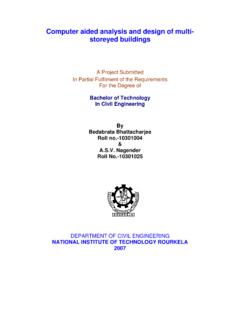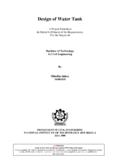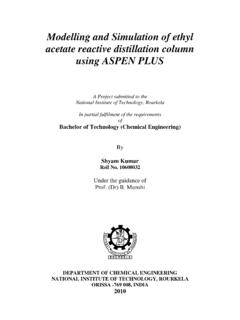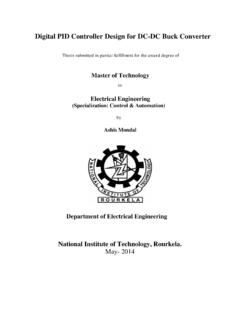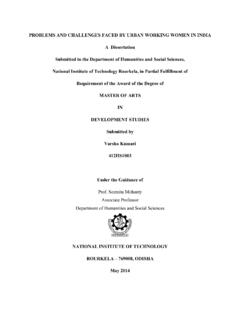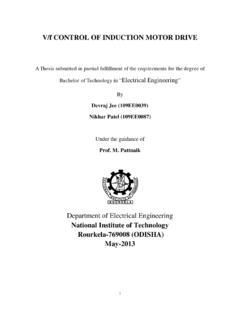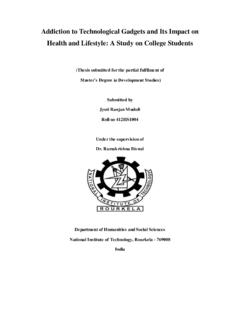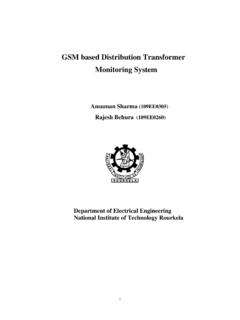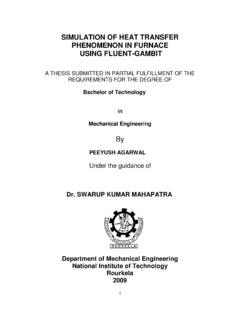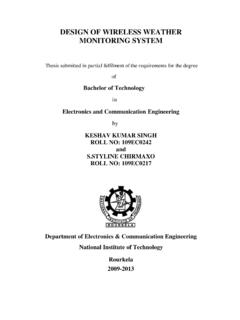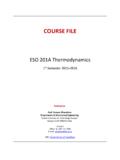Transcription of A Project Report On - ethesis
1 AProject ReportOnTHEORETICAL AND EXPERIMENTAL STUDIES ON PULSE TUBE REFRIGERATORS ubmitted by:Mr. Vivek Kumar RawatRoll No. 10503068 Guided by:Prof. R. K. SahooMechanical EngineeringNIT RourkelaMechanical Engineering DepartmentNational Institute of Technology RourkelaRourkela, Orissa - 769008 CERTIFICATEThis is to certify that the thesis entitled Theoretical and Experimental studies on Pulse Tube Refrigerator , being submitted by Mr. Vivek Kumar Rawat, in the partial fulfillment of the requirement for the award of the degree of B. Tech in Mechanical Engineering, is a record of bona fide research carried out by him at the Department of Mechanical Engineering, National Institute of Technology Rourkela, under our guidance and R. K. SahooMechanical EngineeringNIT RourkelaDate: ACKNOWLEDGEMENTI would like to express my sincere gratitude to my guide Prof. R. K. Sahoo for his invaluable guidance and steadfast support during the course of this Project work.
2 Fruitful and rewarding discussions with him on numerous occasions have made this work possible. It has been a great pleasure for me to work under his guidance. I am also indebt to Mr. Bishwanath Mukharjeeof cryogenics laboratory for his technical support during the experiments which has made this work would like to express my sincere thanks to all the faculty members of Mechanical Engineering Department for their kind would like to acknowledge the assistance of all my friends in the process of completing this work. Finally, I acknowledge my sincere gratitude to my family members for their constant encouragement and Kumar RawatABSTRACTThe absence of moving components at low temperature end gives the pulse tube refrigerator (PTR) a great leverage over other cryo-coolers like Stirling and GM refrigerators that are conventionally in use for several decades. PTR has greater reliability; no electric motors to cause electromagnetic interference, no sources of mechanical vibration in the cold head and no clearance seal between piston and cylinder.
3 Moreover, it is a relatively low cost device with a simple yet compact objectives of the present work are to 1) understand the basic phenomena responsible for the production of cold effect with the help of simple theoretical models based on ideal behavior of gases and to 2) test a single stage GM type pulse tube refrigerator present in the cryogenics lab of Mechanical Engineering Department of NIT Rourkela. Experimental studies consist of cooling behavior of the refrigeration system and suggesting modifications to improve the performance of the PAGE No 1. Introduction Cryocoolers Classification of cryocoolers Pulse Tube Refrigerators Analysis of PTRs Objective 10 2.
4 Literature Review 11-15 3. Experimental Setup and procedure Description of experimental setup 17 Component Description 18-24 Leak Test 24 Experimental procedure 25 4. Results and discussions Generation of pressure pulse 26 Effect of valve openings 26-29 Effect of frequency 29-30 Conclusions 30 Modifications Suggested 30 5.
5 References 31-32 chapter are small refrigerators that can reach cryogenic temperatures and provide refrigeration in the temperature range 10 K to 120 K. The use of cryocoolers has been propelled by many necessities of modern day applications such as adequate refrigeration at specified temperature with low power input, long lifetime, reliable and maintenance free operation with minimum vibration and noise, compactness, and lightweight. The requirements imposed in each of these applications have been difficult to meet and have been the impetus for considerable research in the field of cryocoolers for the past forty applications of cryocoolers are: Liquefaction of gases such as nitrogen, oxygen, hydrogen, helium, natural gas Cooling of super-conducting magnets Cooling of infra-red sensors for missile guidance Cryo vacuum pumps SQUID magnetometers Gamma ray sensors for monitoring nuclear activity Cooling of high temperature superconductors and semiconductors Cryosurgery Preservation of biological materials, blood, biological specimens CLASSIFICATION OF CRYOCOOLERSC ryocoolers are classified into two types based on the type of heat exchanger used: (1) Recuperative cryocoolers and (2) Regenerative cryocoolers.
6 Recuperative types, as shown in figure , utilize continuous flow of the refrigerant in one direction, analogous to a DC electrical system. As a result, the compressor and expander must have inlet and outlet valves to control the flow direction, unless rotary or turbine compressor or expanders are used. The recuperative heat exchangers have two or more separate flow channels. The performance of the recuperative cryocoolers is dependent on the properties of the working fluids used. Also, the maximum exergy loss in most cryocoolers occurs in the compressor. The main advantage of DC cryocoolers, however, is that they can be scaled to any size (up to few MW of refrigeration ). Fig. : Schematic of Recuperative Cryocoolers In regenerative types, as shown in figure , the refrigerant undergoes an oscillating flow or an oscillating pressure analogous to an AC electrical system.
7 The compressor and the pressure oscillator for the regenerative cycles need no inlet or outlet valves. The regenerator has only one flow channel, and the heat is stored for a half cycle in the regenerator matrix, which must have a high heat capacity. The performance of the regenerative type cryocoolers is dependent on the phase difference between the pressure and mass flow rate phasors. Helium is the refrigerant of choice for most regenerative type cryocoolers. The main disadvantage with regenerative type cryocoolers is that they cannot be scaled to large sizes like the recuperative cryocoolers. : Schematic of Regenerative PULSE TUBE REFRIGERATORS (PTRs)The moving displacer in the Stirling and Gifford-McMahon refrigerators has several disadvantages. It is a source of vibration, has a short lifetime, and contributes to axial heat conduction as well as to a shuttle heat loss.
8 In the pulse tube refrigerator, shown in Figure , the displacer is eliminated. The proper gas motion in phase with the pressure is achieved by the use of an orifice and a reservoir volume to store the gas during a half cycle. The reservoir volume is large enough that negligible pressure oscillation occurs in it during the oscillating flow. The oscillating flow through the orifice separates the heating and cooling effects just as the displacer does for the Stirling and Gifford-McMahon refrigerators. The orifice pulse tube refrigerator (OPTR) operates ideally with adiabatic compression and expansion in the pulse four steps in the cycle are as The piston moves down to compress the gas (Helium) in the pulse tube. 2. Because this heated, compressed gas is at a higher pressure than the average in the reservoir, it flows through the orifice into the reservoir and exchanges heat with the ambient through the heat exchanger at the warm end of the pulse tube.
9 The flow stops when the pressure in the pulse tube is reduced to the average The piston moves up and expands the gas adiabatically in the pulse tube. 4. This cold, low-pressure gas in the pulse tube is forced toward the cold end by the gas flow from the reservoir into the pulse tube through the orifice. As the cold gas flows through the heat exchanger at the cold end of the pulse tube it picks up heat from the object being cooled. The flow stops when the pressure in the pulse tube increases to the average pressure. The cycle then repeats. The function of the regenerator is the same as in the Stirling and Gifford-McMahon refrigerators in that it precools the incoming high-pressure gas before it reaches the cold end. The function of the pulse tube is to insulate the processes at its two ends. That is, it must be large enough that gas flowing from the warm end traverses only part way through the pulse tube before flow is reversed.
10 Likewise, flow in from the cold end never reaches the warm end. Gas in the middle portion of the pulse tube never leaves the pulse tube and forms a temperature gradient that insulates the two ends. Roughly speaking, the gas in the pulse tube is divided into three segments, with the middle segment acting like a displacer but consisting of gas rather than a solid material. For this gas plug to effectively insulate the two ends of the pulse tube, turbulence in the pulse tube must be minimized. Thus, flow straightening at the two ends is crucial to the successful operation of the pulse tube refrigerator. ANALYSIS OF PULSE TUBE Enthalpy and Entropy Flow ModelThe refrigeration power of the PTR is derived using the First and Second Laws of Thermodynamics for an open system. Because of the oscillating flow the expressions are simplified if averages over one cycle are made.
